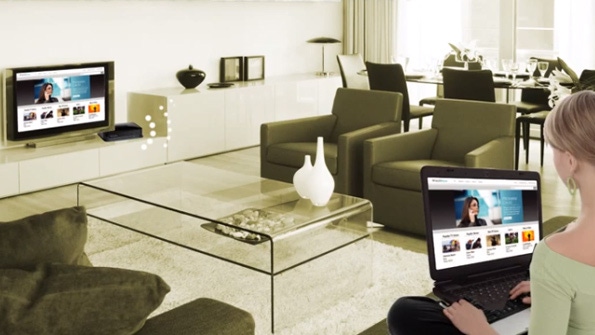Windows 8.1 + Miracast
For most, more trouble than it's worth
November 14, 2013

With Windows 8.1, Microsoft is offering its users a new wireless display option called Miracast. Many will compare Miracast to Apple's superior AirPlay technology. But the truth is, on the multi-touch devices with which this makes the most sense, Miracast isn't magic, and it's often no more useful than an HDMI cable.
Miracast is a new wireless display option in Windows 8.1. That is, it lets you output the display of your Windows PC/device to another screen ... wirelessly. It doesn't replace previous efforts—including using a simple HDMI cable, which to be fair still works the most reliably—but is instead just a new way to make this work. In Microsoft's words, Miracast lets you "wirelessly project to a big screen without fussing with proprietary technologies, network access, and different display cables and adapters." What they don't tell you is that it requires you to fuss with Miracast instead.
Like any other dual-display technology, Miracast can be used in multiple scenarios. Productive office workers could use it to project a PowerPoint presentation to a projected screen for an audience while they continue to use their PC's screen to control the presentation, access their notes, and so on. Consumers might want to use Miracast to trigger the playback of a PC-based movie on their HDTV.
Miracast and similar technologies like AirPlay require three pieces. First, you need a PC/device that supports Intel's Wi-Di technology, and in this case I'll assume Windows 8.1 (including Windows RT 8.1). Second, you need an external screen of some kind, like an HDTV. And third, you need a Miracast-compatible adapter that will wirelessly connect to your PC and then transmit the display, over HDMI, to that HDTV. (In the AirPlay world, that last bit is served by an Apple TV.)
Assuming Miracast takes off, it's possible we could simplify the pieces down to two: Maybe we'll someday have Miracast-compatible HDTVs everywhere, eliminating the Miracast adapter bit. But for now, there are three pieces.
By the way, there are exactly two Miracast adapters on the market right now, the ActionTec ScreenBeam Pro and the Netgear Push2TV (PTV3000). I'm using the latter, which is about the size of an Apple TV or Roku, but just one-half the height. It's tiny.
Setting up Miracast can be difficult. First, you need to update the firmware on the adapter, which in the case of the Netgear device involves praying to a harvest deity during a full moon and other technical arcana which I'll leave to Netgear's incredibly well-written documentation. Then, you connect the adapter to your HDTV via HDMI and to a power supply. (If you're lucky, your HDTV has a spare USB port, and you can charge the adapter that way, as you might with a Chromecast.)
Then the fun really starts, and you can connect the Miracast adapter to your PC. I've tested it with both Windows 8.1 and Windows RT 8.1 (using Surface 2) and it works the same with both: You bring up the Devices charm, tap Project, and then tap "Add a wireless display" from the Project pane.
PC Settings will load and attempt to the find the device.
Somewhat like Bluetooth devices, you'll be prompted to enter a PIN to complete the connection.
And then the device is added and you can use it as you would any second display. That is, you navigate to that Project pane (WINKEY + P is fastest) and then choose how you wish to use the second display.
For that PowerPoint example noted above, you would want to use Extend. But in the home, a more common scenario, I guess, would be to display content from the PC/device onto your HDTV. So you'd choose Duplicate, which replicates what you see on the device's screen on the television as well.
And this works OK, to be fair. You can show a photo slideshow or whatever and it works as expected.
The problem is that Miracast wireless display is as "dumb" as using an HDMI cable. When you're streaming a movie from the PC/device to the HDTV, for example, you want to watch that content on the HDTV only, not duplicated on both screens. But Miracast is just a way to use the normal Project mechanism in Windows ... wirelessly. There's no smarts to it. And it's more expensive and harder to use than a regular HDMI cable.
By comparison, you can use Xbox Video with the Play on Xbox feature and use the Xbox SmartGlass app as a smart remote. So while you're still triggering video playback from the PC/device to the HDTV, you can then use your PC/device as a smart remote control. And depending on the content, you'll have amazing second screen functionality too.
And if you're familiar with AirPlay on iOS, well. Don't even get me started. It's like Play on Xbox and Miracast all rolled into a single feature. Which, when you think about it, is what Play on Xbox, Play To and Miracast should be: A bunch of technical ugliness hidden under a single, easy to use Windows feature.
A couple of final points. Some will note that Miracast is unavoidable on some devices, like the Dell Venue 8 Pro, which lacks HDMI-out. Fair enough. And some—features like Miracast seem to attract technical people with too much time on their hands—will claim that Miracast works just fine and they see no issues with it. I suspect that won't be true for average users, however.
Ultimately, Miracast is exactly as described: It's just a wireless way to duplicate or extend your PC's display ... literally, the wireless version of an HDMI cable. Just make sure you understand that's all this is.
About the Author
You May Also Like






.jpg?width=700&auto=webp&quality=80&disable=upscale)
